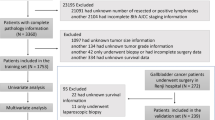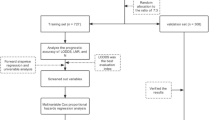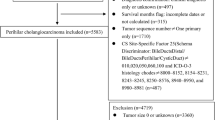Abstract
Background
The impact of tumor size on account of the long-term survival results in gallbladder cancer (GBC) patients has been controversial. It is urgent necessary to identify the optimal cut-off value of tumor size in resected GBC, and we attempted to integrate tumor size with other prognostic factors into a prognostic nomogram to predict the cancer-specific survival (CSS) of GBC patients.
Methods
1639 patients with resected GBC were extracted from the Surveillance, Epidemiology and End Results (SEER) database. X-tile program was used to identify the optimal cut-off value of tumor size. A nomogram including tumor size was established to predict 1-, 3- and 5-year CSS based on the independent risk factors chosen by univariate and multivariable cox analyses. The precision of the nomogram for predicting survival was validated with Harrell’s concordance index (C-index), calibration curves, and receiver operating characteristic curve (ROC) internally and externally.
Results
Patients with GBC were classified into 1–13 mm, 14–63 mm and 64 mm subgroup based on the optimal cut-off for tumor size in terms of CSS. The nomogram according to the independent factors was well calibrated and displayed better discrimination power than 7th tumor–node–metastasis (TNM) stage systems.
Conclusions
The results demonstrated that increased tumor size is closely associated with the worse CSS. Our novel nomogram, which outperforms the conventional TNM staging system, showed satisfactory accuracy and clinically practicality for predicting the outcome of resected GBC patients.





Similar content being viewed by others
Data availability
The data that support the findings of this study are available from each participating registry but restrictions apply to the availability of these data, which were used under license for the current study, and so are not publicly available.
References
Lau CSM, Zywot A, Mahendraraj K et al (2017) Gallbladder carcinoma in the United States: a population based clinical outcomes study involving 22,343 patients from the surveillance, epidemiology, and end result database (1973–2013). HPB Surg 2017:1532835
Smith GC, Parks RW, Madhavan KK et al (2003) A 10-year experience in the management of gallbladder cancer. HPB (Oxford) 5:159–166
Shukla SK, Singh G, Shahi KS et al (2018) Staging, treatment, and future approaches of gallbladder carcinoma. J Gastrointest Cancer 49:9–15
Baiu I, Visser B (2018) Gallbladder cancer. JAMA 320:1294
Hundal R, Shaffer EA (2014) Gallbladder cancer: epidemiology and outcome. Clin Epidemiol 6:99–109
Chun YS, Pawlik TM, Vauthey JN (2018) 8th Edition of the AJCC Cancer Staging Manual: pancreas and hepatobiliary cancers. Ann Surg Oncol 25:845–847
Zhang W, Hong HJ, Chen YL (2018) Establishment of a gallbladder cancer-specific survival model to predict prognosis in non-metastatic gallbladder cancer patients after surgical resection. Dig Dis Sci 63:2251–2258
Yadav S, Tella SH, Kommalapati A et al (2020) A novel clinically based staging system for gallbladder cancer. J Natl Compr Cancer Netw 18:151–159
Cen D, Liu H, Wan Z et al (2019) Clinicopathological features and survival for gallbladder NEN: a population-based study. Endocr Connect 8:1273–1281
Freedman AN, Seminara D, Gail MH et al (2005) Cancer risk prediction models: a workshop on development, evaluation, and application. J Natl Cancer Inst 97:715–723
Collins GS, Reitsma JB, Altman DG et al (2015) Transparent reporting of a multivariable prediction model for individual prognosis or diagnosis (TRIPOD): the TRIPOD statement. BMJ 350:g7594
Lei Z, Li J, Wu D et al (2016) Nomogram for preoperative estimation of microvascular invasion risk in hepatitis B virus-related hepatocellular carcinoma within the milan criteria. JAMA Surg 151:356–363
Chen S, Liu Y, Yang J et al (2019) Development and validation of a nomogram for predicting survival in male patients with breast cancer. Front Oncol 9:361
Hanley JA, McNeil BJ (1982) The meaning and use of the area under a receiver operating characteristic (ROC) curve. Radiology 143:29–36
Coutant C, Olivier C, Lambaudie E et al (2009) Comparison of models to predict nonsentinel lymph node status in breast cancer patients with metastatic sentinel lymph nodes: a prospective multicenter study. J Clin Oncol 27:2800–2808
Feng J, Polychronidis G, Heger U et al (2019) Incidence trends and survival prediction of hepatoblastoma in children: a population-based study. Cancer Commun (Lond) 39:62
Aloia TA, Jarufe N, Javle M et al (2015) Gallbladder cancer: expert consensus statement. HPB (Oxford) 17:681–690
Randi G, Franceschi S, La Vecchia C (2006) Gallbladder cancer worldwide: geographical distribution and risk factors. Int J Cancer 118:1591–1602
Sharma A, Sharma KL, Gupta A et al (2017) Gallbladder cancer epidemiology, pathogenesis and molecular genetics: recent update. World J Gastroenterol 23:3978–3998
Zatonski WA, Lowenfels AB, Boyle P et al (1997) Epidemiologic aspects of gallbladder cancer: a case-control study of the SEARCH Program of the International Agency for Research on Cancer. J Natl Cancer Inst 89:1132–1138
Wang SJ, Lemieux A, Kalpathy-Cramer J et al (2011) Nomogram for predicting the benefit of adjuvant chemoradiotherapy for resected gallbladder cancer. J Clin Oncol 29:4627–4632
Acknowledgements
We are very grateful to the staff in Surveillance, Epidemiology, and End Results Program (SEER) for their kind work in data collection and delivery.
Funding
This study was supported by Natural Science Foundation of Jiangsu Province, China (BK20171077) and key research and development program of Jiangsu Province (BE2016789), National Science Foundation of China (NSFC) (81700572, 81670570), National Science and Technology Major Project of China (2017ZX10203207-004-004). The funder had no involvement in study design; in the collection, analysis, or interpretation of data; in the writing of the report; or in the decision to submit the paper for publication.
Author information
Authors and Affiliations
Contributions
Conception or design were provided by XCL and YDZ. Acquisition, analysis, or interpretation of data were supplied by YDZ, TZ and SH. Drafting of the manuscript was done by YDZ and TZ. Critical revision of the manuscript for important intellectual content was imparted by JC. Statistical analysis was contributed by WJJ and ZYW. Administrative, technical, or material support was provided by CXL. All authors have given the final approval of the manuscript for submission and publication.
Corresponding author
Ethics declarations
Conflict of interest
The authors declare that they have no competing interests.
Ethics approval and consent to participate
The investigation was approved by the ethics committee of the First Affiliated Hospital of Nanjing Medical University. Consent was waived considering the anonymous, observational, population-based, and registry-based nature.
Additional information
Publisher's Note
Springer Nature remains neutral with regard to jurisdictional claims in published maps and institutional affiliations.
Supplementary Information
Below is the link to the electronic supplementary material.
About this article
Cite this article
Zhang, Y., Zhou, T., Han, S. et al. Development and external validation of a nomogram for predicting the effect of tumor size on cancer-specific survival of resected gallbladder cancer: a population-based study. Int J Clin Oncol 26, 1120–1129 (2021). https://doi.org/10.1007/s10147-021-01891-2
Received:
Accepted:
Published:
Issue Date:
DOI: https://doi.org/10.1007/s10147-021-01891-2




